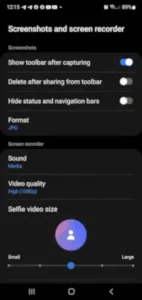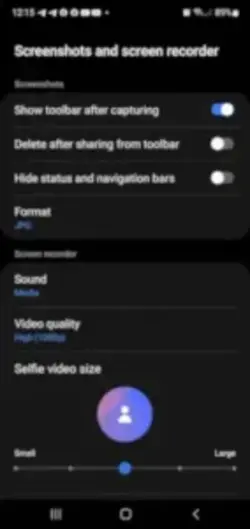Screen recording has become essential and with built in Record Screen Activity you can do a lot of things, whether you’re capturing gameplay highlights, demonstrating app features, or reporting a software bug.

While third party apps flood the Play Store, Android’s native screen recorder offers a no frills solution with surprising depth. No installations, no ads, just swipe and record.
How to Access the Record Screen Activity
Quick Settings (Android 11+)
- Swipe down twice to expand the full Quick Settings panel.
- Tap the pencil icon to edit tiles.
- Drag Screen Record into your active shortcuts.
Fallback Method (Older Androids)
- Some devices support Power + Volume Up to start recording.
Voice Command
Say “Hey Google, start screen recording” (Google Assistant required).
Key Features of Record Screen Activity
HD Recording
- Defaults to 1080p (varies by device). No 4K, but crisp enough for most needs.
Audio Settings
- Mute: Silent recording
- Media Audio: Capture in-app sounds (game audio, music)
- Microphone + Media: Add voiceovers or commentary
Touch Indicators
- Visual feedback shows taps, ideal for tutorial creators.
Toolbar Tools
- Pause: Freeze recording temporarily
- Draw: Annotate live with your finger
- Stop: Ends session and saves to Gallery
App-Specific Mode (Android 14+)
- Record just one app, hiding notifications and other sensitive content.
Step by Step Recording Guide
- Swipe down → Tap Screen Record.
- Adjust settings: Toggle audio sources and touch indicators.
- Wait for the 3-second countdown (prevents accidental starts).
- Control the session: Use the floating toolbar to pause or draw.
- Finish up: Tap Stop → Video saves automatically to Gallery/Videos.
Advanced Tips for Better Screen Recording
Battery Saving Techniques
- Lower screen brightness: Set to 40-50% to significantly reduce power consumption without compromising visibility.
- Enable Battery Saver mode: Limits background processes that drain power during recording.
- Close all background apps: Swipe away recent apps to free up RAM and prevent system slowdowns.
- Disable Bluetooth/GPS: These services consume battery even when not in active use.
- Use dark mode: Helps reduce battery usage on OLED screens during recording.
Professional Editing Options
- Google Photos editing:
- Trim clips with frame by frame precision
- Adjust basic lighting and color settings
- Add slow-motion effects (for supported devices)
- CapCut features:
- Multi-track timeline editing
- Keyframe animation for text/graphics
- Professional grade color correction tools
- Library of royalty-free music and sound effects
- InShot capabilities:
- Custom video canvas sizes
- Advanced text animation presets
- Audio ducking for cleaner voiceovers
Storage Optimization
- Auto-delete settings:
- Configure Google Photos to automatically remove recordings older than 30/60 days
- Set up device maintenance auto-clean for duplicate files
- Resolution selection:
- 720p (HD) reduces file size by ~40% vs 1080p
- Consider resolution needs based on final viewing platform
- Cloud backup options:
- Automatically upload to Google Drive with original quality
- Set up selective sync to preserve local storage
Comprehensive Limitations & Solutions
Editing Functionality
- Native limitations:
- No video cropping or rotation
- Lacks speed adjustment controls
- No audio level mixing
- Recommended solutions:
- CapCut: Best for social media content (TikTok/Instagram)
- PowerDirector: Professional-grade editing suite
- VN Editor: Lightweight option for quick edits
Legacy Device Support
- Android version breakdown:
- Android 10 and below: No native recorder
- Android 11: Basic recording functionality
- Android 12+: Full feature set
- Alternative methods:
- ADB command-line recording (requires USB debugging)
- Manufacturer-specific tools (Samsung Game Launcher)
- Trusted third-party APKs (detailed installation guides)
Power Management
- Battery drain analysis:
- 1080p recording consumes ~15-20% battery per hour
- Microphone usage adds 5-10% additional drain
Comparison with screen record apps
| Feature | Android Native | AZ Recorder | XRecorder | ScreenPal |
|---|---|---|---|---|
| Max Resolution | 1080p | 4K | 1080p | 720p |
| Audio Sources | 3 options | 4 options | 2 options | 1 option |
| Frame Rate Control | ❌ | ✅ (60fps) | ✅ (30/60) | ❌ |
| Live Drawing | Basic | Advanced | Basic | ❌ |
| Cloud Upload | Manual | Auto | Manual | Auto |
| Price | Free | Freemium | Free | Premium |
Key Takeaways:
- Native option best for quick, simple recordings
- AZ Recorder superior for advanced users
- XRecorder good middle-ground alternative
Expanded User Feedback & Community Insights
Positive Experiences
- Reliability: “Never crashes during important recordings”
- Integration: “Perfect sync with Pixel’s screenshot tool”
- Privacy: “App-specific recording hides my notifications perfectly”
Common Complaints
- Feature gaps: “Why can’t I adjust recording resolution?”
- Device variability: “Works differently on my Samsung vs Pixel”
- Audio issues: “System audio sometimes drops randomly”
Future Development Roadmap
Android 15 Enhancements
- Confirmed features:
- Status bar recording controls
- Enhanced privacy indicators
- Optimized battery usage algorithms
- Under development:
- Live streaming integration
- AI-powered auto-editing
- Multi-source audio mixing
Manufacturer-Specific Improvements
- Samsung: Game Recording Suite updates
- Google Pixel: Magic Editor integration
- OnePlus: Hasselblad camera enhancements
Conclusion
Best Use Cases
- Tutorial creation: Combine with touch indicators
- Bug reporting: Perfect for developer communications
- Gameplay sharing: Optimize with external mic
Final Recommendations
- For beginners: Stick with native tool
- For creators: Pair with CapCut/VN Editor
- For professionals: Consider dedicated capture devices
Get Started Now:
- Swipe down notification shade
- Locate Screen Record tile
- Configure your settings
- Start creating!
Pro Tip: Long-press the record button for quick settings access on most devices.
FAQ
Can your phone screen-record? With built-in Record Screen Activity?
Most modern Android devices (Android 11+) include native screen recording. Check your Quick Settings for the Screen Record tile. If missing, try Power + Volume Up or download a trusted alternative.
How do I record gameplay without lag?
- Close background apps
- Lower resolution to 720p
- Disable “Touch Indicators” if not needed
For more tips, visit the official Android support page.
Why can’t I record Netflix or Disney+?
DRM protection blocks copyrighted content. Workarounds violate terms of service, use external capture cards for legal alternatives.
Where do screen recordings save?
Videos auto save to Gallery > Videos or DCIM/ScreenRecordings. Use Google Photos for cloud backup.
5. How to edit screen recordings?
Android lacks built-in tools. Try:
- CapCut: Google Play Store Link
- InShot: Simple cuts and audio mixing
